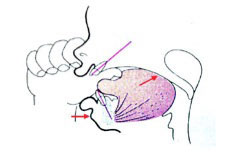Optimizing Growth, Development & Function
It all starts with an understanding that the way Mother Nature designed for us to grow and function is nothing short of a miracle.
The human body is made up of many complex systems that are all coordinated and intertwined. When working as intended, we refer to this as optimization, allowing for us to reach our full genetic potential. But if one of these pieces is not functioning as designed, another type of domino effect can take place that has varying potential consequences.

Dr. Sigal’s background as a Kinesiologist, passion for anatomy and physiology, and additional training in orofacial myofunctional therapy (OMT) has fueled her vision to provide comprehensive, airway centric pediatric health care.
Our philosophy of care at Little Bird is for optimization and prevention, to therefore avoid or minimize treatment and correction at a later, older age.
Essential elements that we can evaluate from Birth to optimize your loved ones growth, development and function include (but are not limited to):
1) Tongue Rest Position and Function
• At rest (when not speaking or eating), tongue should rest UP on the roof of the mouth (palate) just behind the front teeth
• If you say “Boston” or the letter “N”, that is what we refer to as the “Spot” where your tongue should rest
• Correct tongue rest posture provides the necessary forces for optimized palate and jaw formation, and promotes development of the ideal Rocker swallowing pattern (as opposed to the compromised Piston or Tongue Thrust swallow)

The tongue is the captain of growth and development of the bones of the skull and face. Here you will see where the tongue should rest (aka. “Spot”)
© Natalie Cormier with Little Bird
2) Palate (Roof of Mouth) Shape and Development

Tongue to spot
• Optimized Palate Shape: Wide, Flat, Maximal surface area
• Why is a wide, flat palate the optimized form?
a) Because the opposite side of our palate is our nasal airway; ensuring proper palate development is the first step in achieving an optimized nasal (nose) airway (greater volume, less resistance/restriction to air flow)
b) Provides necessary space for all teeth to erupt (with minimal to no crowding)

Wide Palate

Narrow Palate
The image on the left features an individual that rests their tongue on the spot, with their lips sealed at rest and breathes through their nose. Notice the shape of their palate – it is wide, flat, and optimized.
The image on the right features an individual that rests their tongue on the floor of their mouth, has open mouth posture (lips apart), and breathes through their mouth. Notice the shape of their palate – it is narrow, high arched (could fit thumb in the area) and compromised leading to many potential health/function consequences.
3) Nasal Airway – Breathing in and out through our Noses
First, we must understand that noses are for breathing and mouths are for eating, but why you may ask?
Only when I breathe in and out through my nose …
1. Will the air be filtered, warmed/humidified, and air speed regulated to ensure that maximal, purified (clean) air reaches my lungs
2. Will the volume of my upper airway be nearly double that (meaning more air/oxygen reaching my lungs) of if I were to breathe through my mouth (See image 2)
3. Will naturally occurring (from sinuses) nitric oxide (NO) be incorporated into the air I breathe, opening up my nose (decongestant), cleaning the air (purifying), and allowing the air to reach the lower lobes of my lungs (essential for “belly” or diaphragmatic breathing)
4. Will it stimulate my parasympathetic nervous system (rest and digest), lowering my heart rate, potential stress on my cardiovascular system (blood pressure, etc.), and anxiety/worry
5. Will I realize that there are no benefits to my health when I breathe in and out through my mouth
• We utilize the Buteyko method of breathing re-training. Click HERE to learn more.
• For more information and age group specific checklists for possible signs/symptoms of a compromised airway/function click HERE


Image 2: Reference Alves Jr. M et al. (2011). Three-dimensional assessment of pharyngeal airway in nasal and mouth-breathing children. International Journal of Pediatric Otorhinolaryngology 75; 1195-1199.
4) Upper lip range of motion and lip seal at rest
• Proper lip function is desired for optimized nasal breathing (achieving a passive lip seal), feeding and ease of brushing upper teeth
• An optimized and unrestricted upper lip allows for lips to be sealed (closed) at rest without strain (passively), encouraging nasal breathing
• For those breast or bottle feeding, it allows for upper lip eversion (flanging) for optimized latching and milk flow. In addition when spoon feeding, this upper lip eversion further allows for optimal removal of full spoon contents (compared to only taking what is on the top of the spoon)

Lips sealed, neutral line & nasal breathing

Wide mouth, lips everted, optimized latch
5) Chewing and use of muscles (diet, feeding)
• Muscular activation (chewing on both sides of mouth) is the greatest stimulator for the growth of the upper (maxilla) and lower (mandible) jaws
• We encourage that children use their chewing muscles from 6 months of age onwards for optimized growth and development of oral sensory skills
• Strongly correlated to less picky eaters and improved digestion


6) Sleep
• One of the most important times of the day for neurocognitive development of our children is when they are asleep* (*achieving quality, deep sleep)
• Nasal (nose) breathing allowing for maximal oxygen delivery is an essential component to achieving quality, deep sleep (where neurocognitive development, rest and repair takes place)
• Lack of quality, deep sleep may lead to many potential consequences including outbursts, mood swings, hyperactivity, and difficulty maintaining focus or concentration


Lips sealed, quiet and gently nasal breathing for optimized sleep.
 The growth potential for children 5 years of age and under is tremendous, and no other time point in life remotely compares.
The growth potential for children 5 years of age and under is tremendous, and no other time point in life remotely compares.
If we can ensure optimized breathing and function during these critical years of rapid growth, we will be laying the best possible foundation for our children to reach their full genetic potential.
As mentioned already, our philosophy of care at Little Bird is for optimization and prevention, to therefore avoid or minimize treatment and correction at a later, older age. This is why we work collaboratively with pre/post natal health care providers, to see babies within the first two weeks of life- ensuring optimized tongue and lip rest posture, nose breathing, sleeping and feeding.
Beyond babies, ALL new patients at Little Bird will receive a comprehensive airway centric examination that includes but is not limited to the evaluation of their breathing, sleeping, diet/chewing /swallowing and teeth. No matter how old your child is, identification and treatment can be beneficial. (To learn more about our Services including Buteyko breathing and Orofacial myofunctional therapy click HERE)
Growth and Development is a dynamic interaction that requires constant evaluation
What are some anatomical causes that could lead to suboptimal growth, development and function?
• A restricted/tethered tongue (tie) preventing it from resting up against the palate
• A tongue that’s rest posture has been trained to be down towards the floor of mouth (muscle memory)
• An upper lip that is restricted (lip-tie) likely causing difficulties breastfeeding, and/or increasing the tendency of open mouth rest posture (lips apart) and mouth breathing
• Tongue and/or lip restrictions (ties) increasing the individual’s tendency for compromised mouth breathing
• Anatomical nasal obstruction impeding the ability to nasal breathe
• A diet limited to soft foods thereby not utilizing their chewing muscles
• Chewing on one side of your mouth instead of bilaterally (both) stimulating potential for asymmetric growth of the jaws
• A palate that is narrow, collapsed with a high arched vault *secondary to compromised tongue rest position
Some of the potential consequences of compromised growth and development include (but are not limited to):
• Difficulties breastfeeding
• Colic
• Reflux (GERD)
• Chronic Infections (Ear infections, Strep throat, tonsillitis)
• Compromised sleep
• Hyperactivity/ADHD
• Reduced performance, energy or productivity
• Bedwetting
• Picky eater (avoidance of hard, crunchy, fibrous foods)
• Breathing disordered sleep
• Obstructive sleep apnea
• Forward head posture, neck stiffness/soreness
• Headaches and migraines
• Dental crowding/Malocclusion
Repetition, Muscle Memory and Good Habits
Children learn through repetition, especially newborns and infants, and both the tongue and majority of the face including our airways are comprised of muscle. Therefore, we must ensure to be repeating desired actions and functions in order to maximize the likelihood of developing optimized, retained muscle memory in line with the essential components for optimized growth, development and function.

Repetition → Habituation → Retention of Function
At Little Bird we encourage…
1) Breastfeeding, for as long you feel appropriate. The American Academy of Pediatrics (AAP) recommends exclusive breastfeeding for the first 6 months.
2) Once an infant can sit up, encourage drinking from an open cup or spoutless cup
(Use of spoutless cups allows for the tongue to be positioned upwards)
3) Chewing with products that do not block or cover the tongue for soothing, teething and gumming. Products should not impede tongue rest position against the palate. Speak to our team at Little Bird to learn more.
4) Practice Baby Led Weaning. Encouraging appropriate chewing, swallowing, and use of their facial muscles. From 6 months of age, having our infants develop oral sensory skills, utilizing their musculature through bilateral (both side) chewing of semi fibrous/hard foods promotes optimized growth and development of their jaws.
What about oral (mouth) habits? (Thumb, Fingers, Sucking, Chewing Blankets, etc.)
Any habit that is practiced with enough duration (time), frequency, and intensity has the ability to alter or impede optimized growth, development and function.
Especially if the oral habit is preventing:
1) The Tongue from resting upwards against the palate
2) The Lips from being closed (sealed) at rest
3) The individual from breathing through their nose
Note: Newborns until age 1.5/2 years old may commonly suck their fingers, hands or thumbs as either a communication cue (demonstrating that they are usually hungry or tired), or they are in their “mouthing” stage of growth and development. These types of non-nutritive sucking habits tend to self resolve as they approach 1.5/2 years old and/or able to communicate.
For extended non-nutritive sucking habits (beyond age 2), we would encourage you to schedule an appointment to evaluate how we can help re-educate healthy habits that will optimize your loved ones growth and development.


Images Above: Combination of restricted tongue, thumb sucking habit, low tongue rest position, and tongue thrust swallow leading to mouth open at rest and crooked teeth
